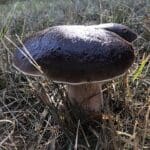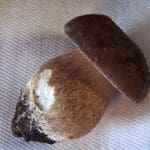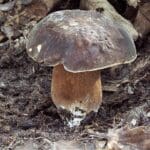Bronze bolete / Summer / Autumn / Edible
A lovely mushroom, the Bronze Bolete passes our three bolete test rules which are, ‘red or blue may make you spew, if it’s bitter leave it out of dinner.’
This is a good chunky edible mushroom and although we don’t find it so often we do come across it enough to learn what it is, most often confused for the porcini, it’s not quite as prized in flavour but it’s not too far off.
Scientific Name
Boletus aereus
Common Names
Bronze bolete, Dark peppy bun, Dark cep, Queen bolete
Family
Boletaceae
Habitat:
Ectomycorhizal meaning in relationships with trees.
Found in deciduous woodland particularly with Beech and Oak.
Summer and autumn
Not very common in Britain, more frequent in southern parts of Europe.
Description
A delicious edible mushroom, by far one of the best bolete species just as tasty as the penny bun. Certainly a beginner friendly fungi, as not only it is a bolete but it displays no red and no blue.
Looking very similar to the penny bun with a darker cap.
Identifying Features:
Cap
The cap is a dark brown, 5-30cm across, a downy texture at first, tiny cracks can appear with age making it feel a little rough. Irregular convex shaped.
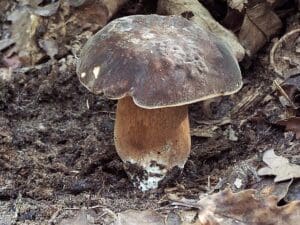
Stem
Very bulbous and stout sometimes as wide as it is tall and often as wide as the cap on young mushrooms.
light brown with darker brown reticulation ( netting) or blotches.
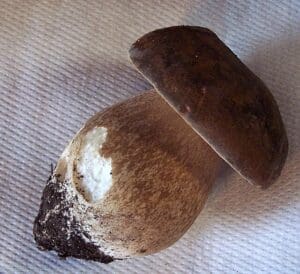
Flesh
Thick, firm and white. Unchanging when cut, though it can darken slightly when bruised.
Underside (fertile side)
Underneath looks like a fine sponge with hundreds of tiny pores, the Bronze bolete like all boletes are polypores so will not have gills. These are white in young specimens, turning yellow as the mushroom matures. The tubes are the same colour as the pores.
Smell
Mushroomy, nutty.
Spores
Olive Brown
Known hazards
None known.
Potential lookalikes for the Bronze Bolete
Could be confused with many brown toned non bluing boletes and lucky you if you find them as they are all safe and many just as delicious.
One you wouldn’t want to confuse is the Bitter Bolete,(Tylopilus felleus). These aren’t dangerous, but taste awful! So will ruin your recipe. These are overall lighter in colour and have a pink tinge to the pores.
Other brown boletes such as Pine Bolete (Boletus pinophilus), or Summer cep (Boletus reticulatus) are also similar. As long as you avoid any bolete that has red or blue staining on it, you can be certain it is safe to eat.
Uses:
In food
They taste amazing! It has a strong mushroom flavour with undertones of nuttiness and a great texture.
They can be dried for longer storage, which intensifies the flavour.
They can then be re-hydrated into wet recipes like stews, stock and pasta sauces or one of our favourites powdered! Then they can easily be added to almost anything to give a rich mushroomy caramel like flavour. H
ave an experiment, the powered mushroom can even be infused into alcohol and made into ice creams so very versatile.
Find all of our Porcini Recipes here
In Medicine
Like many mushrooms it is a good source of protein, minerals and B vitamins.
Sources
More info here



